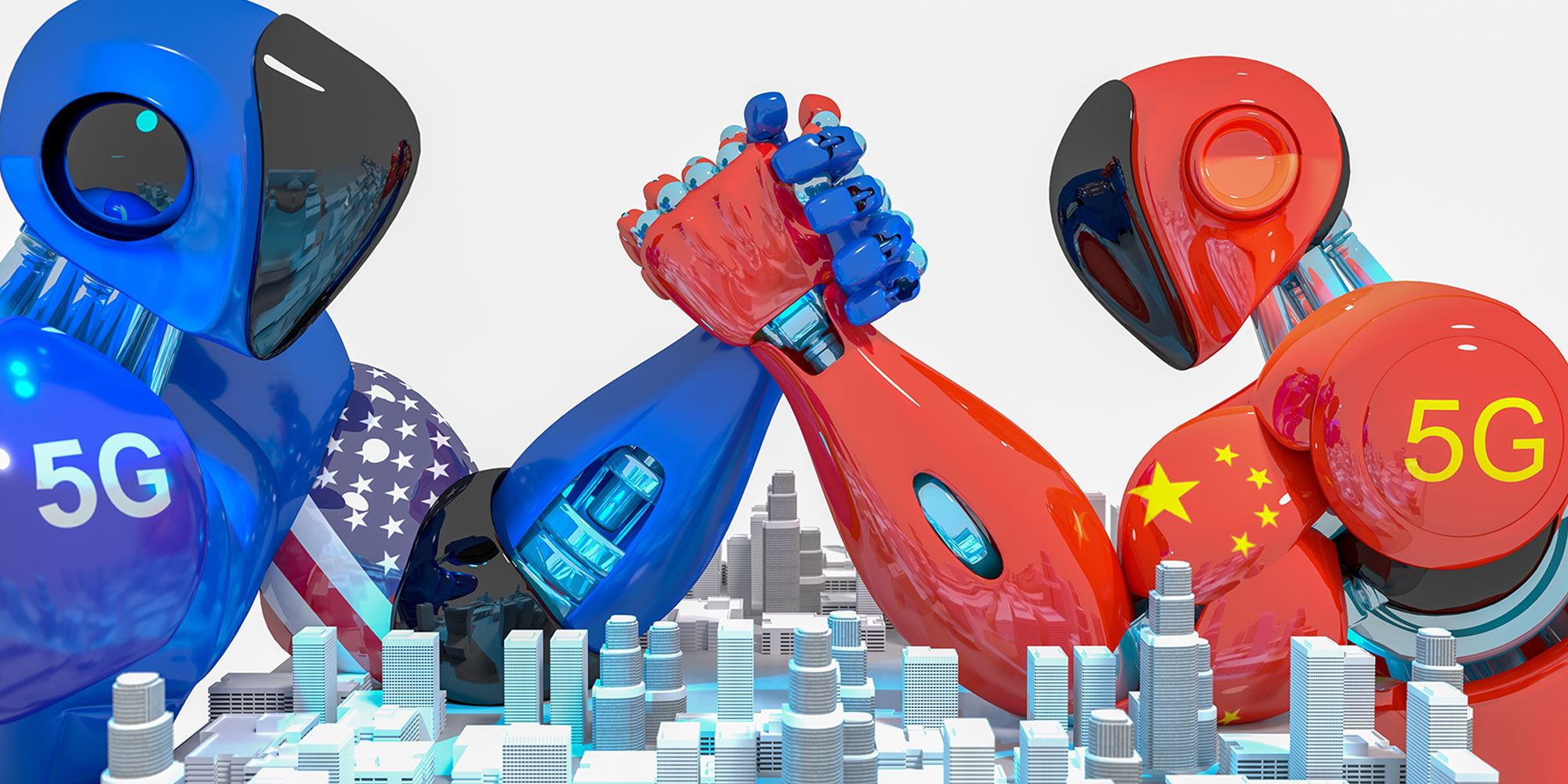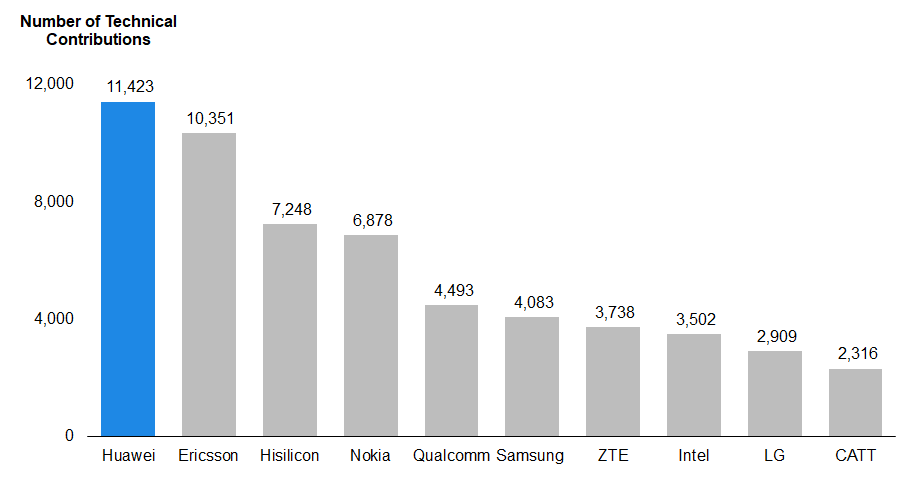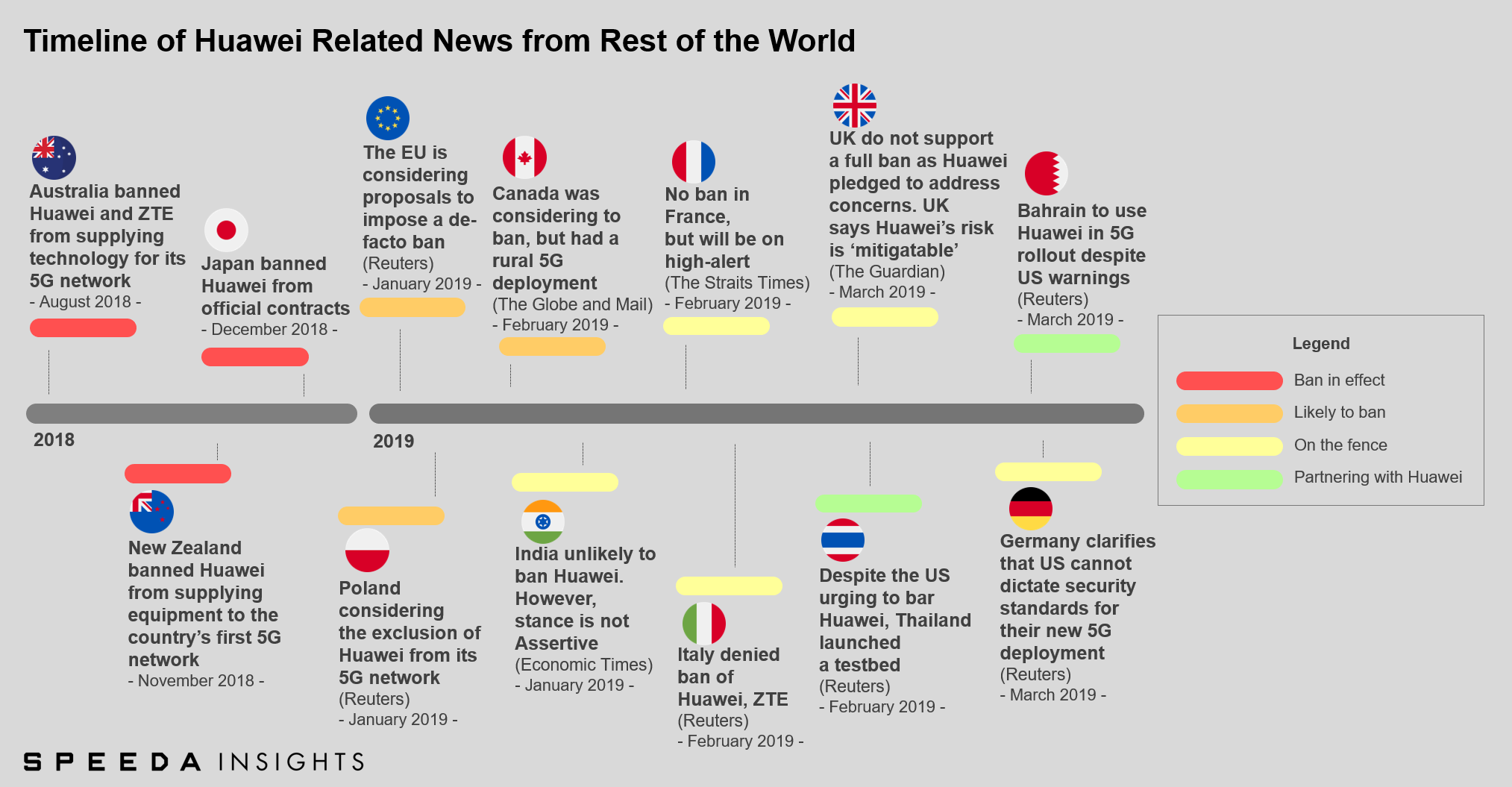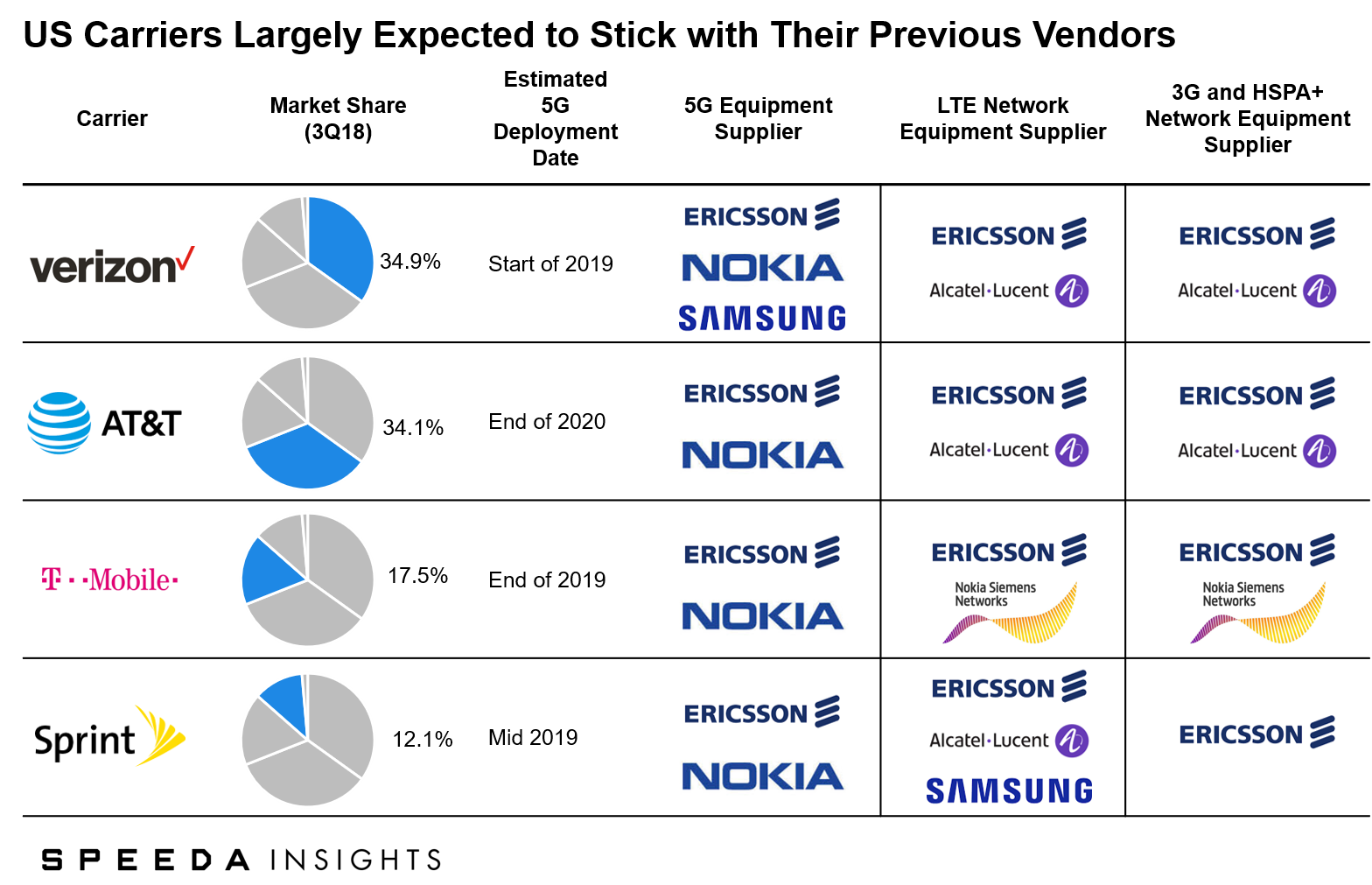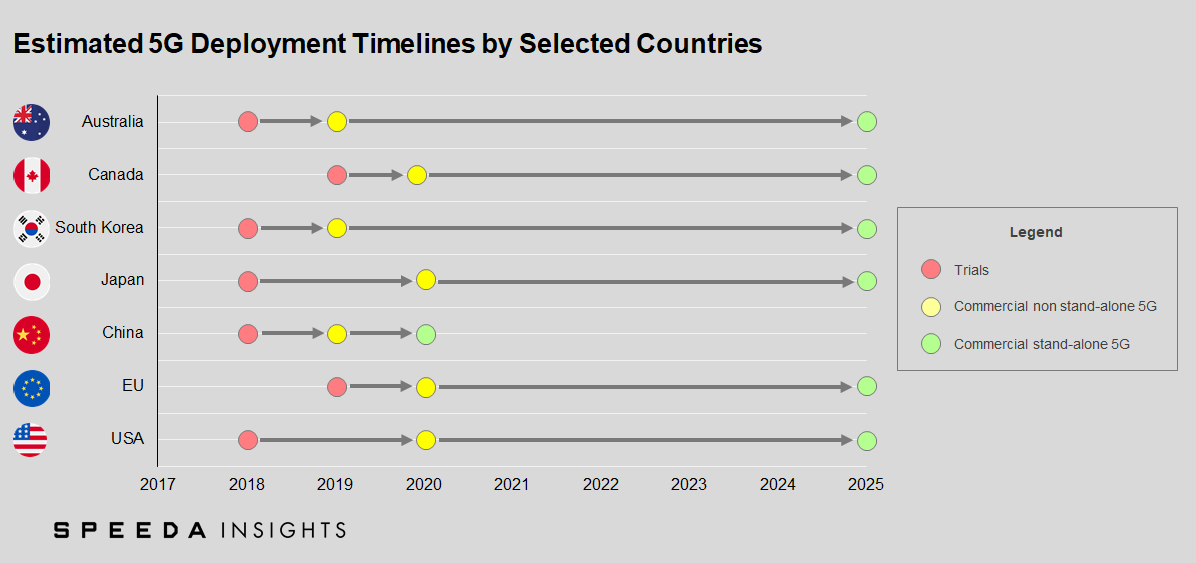5Geopolitics: How Will the US-led Ban on Huawei Affect the Global Rollout?
|
Fifth-generation (5G) wireless technology is the next major phase in telecommunication evolution and a key facilitator of many potential mega-trends ranging from connected cars to Internet-of-Things and smart cities, to name a few. According to Deloitte, 5G will be the foundation for countries’ long-term national economic potential at least until 2030E. |
|
As a result, we witness many countries racing to be the first in the world to commercially deploy 5G as first-adopter countries can sustain more than a decade of competitive advantage, as evidenced in prior wireless technology deployments. |
|
An added complexity in the global 5G rollout is the USA is currently in dispute with the world’s largest network infrastructure supplier, Huawei (CHN), making their lead to win the 5G race a close-called one. The USA is concerned with using Chinese technology in their telecommunication infrastructure, claiming that usage of Huawei’s or ZTE’s (CHN) products can threaten national security as the Chinese state is able to commandeer such companies to comply with its requests in information gathering efforts. |
|
In the country’s previous deployments of telecommunication technology, the USA fared well without Huawei, even being the first to commercially deploy 4G in mass scale, largely by depending on Ericsson (SWE), Alcatel-Lucent (FRA) and Nokia (FIN) who were also market leaders at the time. What makes 5G rollout different compared to 4G is that Huawei seems to have clear a headway in terms of technological prowess, deployment ability and many other criteria. This makes Huawei an important stakeholder in 5G adoption globally. |
|
We see that the USA and China are likely to continue 5G coverage with their respective incumbent operators. However, the rest of the world would have to choose Huawei for their 5G rollout or opt for alternatives. A few countries have already followed the USA’s ban including Australia, New Zealand and Japan, while some others like Indonesia, Thailand and Bahrain have confirmed their usage of Huawei. Further, we also witness that several European countries such as the UK, Germany and Poland are still exploring options on how to manage Huawei’s involvements in their 5G rollouts. |
|
China on the other hand has the unrestrained ability to harness Huawei seamlessly. The country is also backed by strong infrastructure investments by carriers, 5G readiness underlay and proactive state support, all of which thrusts China to the forefront of the 5G deployment race. According to Eurasia Group, China could have commercial standalone 5G as early as 2020E (compared to 2025E for other key countries like USA, Japan and South Korea). |
|
Huawei has Faced Bans in the USA Since 2012 Based on Allegations that Its Offerings Pose a Threat to the National Security |
|
In August 2018, President Donald Trump signed the National Defense Authorization Act (filed in March 2019) to restrict the federal government from using any telecommunication or surveillance products, components or services provided by Huawei and other Chinese technological firms (reported by TechCrunch). The Act also directed that replacement funds be allocated to agencies or companies that needed to substitute Chinese equipment. The ban will be in effect till around 2020. |
|
It should be noted that the ban in 2018, where the USA recommended against the use of Huawei and ZTE’s networking equipment and other consumer electronics by carriers such as Verizon (USA) and AT&T (USA), was not Huawei’s first. The US government urged carriers such as AT&T to switch to alternative vendors even as far back as 2012. As a result, no US carriers or government agencies use Huawei on a large scale. |
|
According to the USA, companies such as Huawei and ZTE pose a threat to national security, given that these companies can be compelled to cooperate with information gathering requests by the Chinese state. According to China’s National Intelligence Law of 2017 and Counter-Espionage Law of 2014, firms are obliged to cooperate with the government by providing them relevant evidence truthfully and may not refuse. |
|
As a result of these bans (starting from 2012) in the USA, Huawei’s US revenue made up only 6.5% of top line in 2017 and grew at the slowest CAGR among all geographies – only 4.3% over 2011–17 (in contrast total revenue growth of 19.3%) – indicating that the region was of no significance to the company either. |
|
|
|
Source: Recreated by UZABASE based on EE Times, ComputerWorld UK and various other sources |
|
Note: The timeline’s events are not exhaustive |
|
Top Line from Americas was Never High; However, Huawei Has Formidable Exposure to Europe and Asia Ex-China |
|
|
|
Source: Company filings |
|
Note: Total revenue only. Breakdown of Huawei’s carrier business revenue by geography not available |
|
Note: CAGR for Other (rest of world) segment not provided in analysis due to periodical inconsistency |
|
Huawei’s Absence Did Not Impact USA’s 4G Rollout as Ericsson, Nokia and Alcatel-Lucent Filled the Void Successfully |
|
Despite not using Huawei as a telco equipment vendor, the USA successfully led 4G deployment globally, reaching an adoption rate of around 65% by 2016 (about five percentage points above Japan, number two at the time). Recon Analytics attributes the country’s accelerated 4G deployment to industry innovation, substantial mobile operator capex budgets (USD 117 billion during 2007–11) and the government’s favourable wireless policymaking (increasing supply spectrums, multiple bandwidth auctions, and expediting tower siting permits). |
|
According to Reuters, Ericsson was the US market leader for telco infrastructure provision since around 2012 when 3G expansion and new 4G rollouts were taking place. The company worked with all four Tier 1 US carriers who collectively covered over 97% of the market at the time. Alcatel-Lucent was in second place, followed by Nokia-Siemens Networks (NSN). NSN made strong market gains around 2012 due to promising restructuring plans and posed significant competition to the global leaders at the time – Ericsson and Huawei. |
|
NSN eventually acquired the financially troubled Alcatel-Lucent in 2015, making the US market a near duopoly with the merged entity alongside Ericsson. It should also be noted that there were no significant Asian telco equipment suppliers in the US market during that time except for Samsung (KOR), who had only a rather small contract with Sprint (USA). |
|
In the meantime, Huawei, who supplied geographies excluding the USA, dethroned Ericsson to be the largest telco equipment firm globally due to 4G contract wins in ex-US markets. Around 2012, Huawei marketed itself as a ‘low cost’ option whose reasonable tenders allowed them to win large scale commercial contracts in emerging markets. |
|
USA was the First to Adopt 4G Among Key Countries (2017) |
|
|
|
Source: Recreated by UZABASE based on Ovum Forecaster, 2017, and Recon Analytics analysis |
|
Note: Data is estimated |
|
Unlike the Scenario with 4G, Huawei is Well Ahead in Terms of 5G Technology |
|
5G technology is considered the successor of 4G and LTE networks in the telecommunication industry, and is a powerful accelerator of the next industrial evolution. As per IHS Markit, research findings show that 5G can enable global sales activity worth USD 12.3 trillion in 2035E, equivalent to 4.6% of all global real output for the same period. |
|
Furthermore, being the first to deploy 5G gives a country a technological edge and, in turn, leads to at least a decade-worth of benefits. This may be why many countries were rapidly testing and deploying 5G even in 2018 or earlier. |
|
For more information on 5G technology, refer to our SPEEDA Insight report: “Global 5G Race – Will Asia Speed to the Lead?” |
|
|
|
Source: Compiled by UZABASE based on various materials |
|
Note: 1 Gbps = 1,024 megabyte per second (Mbps); 1 Mbps = 1,024 kilobyte per second (Kbps) |
|
Note: The year refers to the year of initial launch, although the speeds, latency, and density do not necessarily correspond to characteristics at the initial launch |
|
Note: 5G is likely to be commercially rolled out during 2019–20; however, a pre-commercial 5G trial took place in South Korea during the winter Olympics in February 2018 |
|
|
|
Source: GSMA, “5G Spectrum: Public Policy Position”; PreScouter, “How will 5G impact different industries?” |
|
Note: The illustration is indicative only; the list of industries is not exhaustive |
|
Note: Although certain characteristics have a higher impact on certain industries, most industries require a mix of 5G features |
|
|
|
Source: Ericsson, “The Industry Impact of 5G” |
|
Note: The illustration is indicative; the list of industries is not exhaustive |
|
In terms of companies that can make 5G a reality, Huawei remains the leader. This is evident from Huawei’s global lead in 5G standard contributions made as of 2018. The company made 11,423 technical contributions, ahead of number two Ericsson’s 10,351 contributions and number three Hisilicon – which is fully owned by Huawei. |
|
Such technical contributions are made possible by Huawei’s industry leading R&D budget of USD 15.4 billion in 2018 (vs. USD 5.5 billion by Nokia in 2018). In fact, Huawei’s R&D allocation was the fifth-largest budget of any company in the world in 2018. |
|
Huawei Made the Most 5G Standard Contributions as of 2018 |
|
|
|
Source: Statista based on IPlytics GmbH |
|
Note: Technical contributions are submissions made by companies in the standardization process of 5G technology which is an indicator of involvement and investment by each company in the development of the 5G standard |
|
Compared to Industry Peers, Huawei Spearheads Innovation Commitments |
|
|
|
Source: Company filings |
|
In terms of hardware, Huawei’s leadership in the global telecom infrastructure market (around 29% market share in 2018 as per Dell’Oro research) gives the company an upper hand when it comes to rollouts. 5G technology will require many small base stations and Huawei is capable of mass-supplying these. This is evident in their deployment of around 47,000 base stations for 30 commercial contracts as of February 2019. Comparatively, Nokia and Ericsson have 16 5G wins each as of the same date. |
|
Within the overall telecom equipment market, mobile Radio Access Network (RAN) equipment remains the cornerstone segment, alongside optical transport equipment. Ovum, a telecommunication research company estimates that 2017 sales of RAN gear was around USD 32.1 billion with Huawei claiming the lion’s share of 30.1%. |
|
Huawei is the Global Telecom Infrastructure Market Leader Since Mid-2014 |
|
|
|
Source: Dell’Oro Group and Capacity Media |
|
Note: Market value is estimated based on Ericsson’s revenue |
|
Note: Figures are estimated |
|
Note: The top seven manufacturers drew around 80% of global telco equipment sales 2018 |
|
Note: Equipment included above consists of broadband access, carrier IP telephony, microwave transmission and mobile backhaul, mobile RAN, optical transport, service provider router and carrier Ethernet switch, telecom capex, wide area internet of things (IoT) and wireless packet core |
|
Huawei’s RAN Scale Remains Largest in 2018; Global Reach Lags Nokia and Ericsson Due to Bans |
|
|
|
Source: Ovum |
|
Note: Bubble size approximates current market share |
|
Note: Figures are estimated |
|
According to techradar.com, Huawei also promises simpler installation and low running costs in terms of maintenance and utility consumption, making it a very attractive option for telco equipment purchasers. As 5G technology requires a large volume of smaller base stations, daily operational cost can make up a substantial expenditure. Therefore, it is of utmost importance for carriers to minimise this and, in turn, opt for energy-friendly options. |
|
Furthermore, Huawei’s market leadership in the telco software and professional services market (ability to offer end-to-end solutions) offers it a competitive edge over all other players, as the setup and maintenance of 5G will predominantly be via software. |
|
According to Phys.org quoting industry experts, Huawei is also around 6-12 months ahead of Ericsson in terms of the quality of the 5G equipment. |
|
|
|
Source: Compiled by UZABASE based on Techradar, LightReading and other sources. Icons made by multiple authors from www.flaticon.com |
|
USA and China Already Polarised on 5G Rollout; Will the Rest of the World Harness Huawei’s Market Leadership? |
|
Considering the USA’s ban on Huawei (despite its leadership in 5G technology), we can divide the market into three geographic segments, namely: |
|
(1) Rest of the world (i.e. ex-China and ex-USA); |
|
(2) USA; and |
|
(3) China |
|
We see that the USA and China will likely continue coverage with their incumbent operators. However, the rest of the world would have to choose Huawei for their 5G rollout or opt for alternatives. Details of each of region are discussed below. |
|
(1) Rest of the World: USA has Been Influencing Other Countries to Refrain from Using Huawei |
|
According to Dow Jones Institutional News, the USA has been influencing their allied counterparts including the EU to refrain from using Huawei for the same security concerns behind their own prohibition. |
|
A few countries have already followed the USA’s ban including Australia, New Zealand and Japan, while some others like Indonesia, Thailand and Bahrain have confirmed their usage of Huawei. |
|
Further, we see that several European countries such as the UK, Germany and Poland are still exploring options on how to manage the USA’s terms while remaining competitive. A Huawei ban in Europe can be disastrous as the region’s carriers can face high replacement and overhaul costs to remove previously installed, un-interoperable Huawei SingleRAN technology. This can lead to exorbitant subscriber rates and thus weaker adoption. |
|
South Korea has also been identified as a close frontrunner for 5G. However, the country seems to be in no rush to carry out a large-scale rollout where they plan to cover enterprise customers before consumers. A larger scale deployment will be seen later than 2019E. |
|
|
|
Source: Created by UZABASE based on multiple sources. Icons made by Freepik from www.flaticon.com |
|
|
|
(2) USA: Ericsson and Nokia Already Selected as 5G Vendors; Samsung May Also Play A Part |
|
Within the USA, AT&T and T-Mobile (USA) stuck with previous hardware vendors, Ericsson and Nokia. Verizon Wireless (USA) (US market leader by subscriber market share) listed Samsung in addition to Nokia and Ericsson as primary suppliers for existing LTE expansion and new 5G networks around March 2018. In previous network deployments, only Sprint (number four in the market) had a supply contract with Samsung. However, for 5G, Sprint only renewed Ericsson and Nokia. |
|
The Korean vendor may be playing Nokia’s previous part in the USA as the third vendor during the 4G rollout, with a likely intention of enhancing competition as larger vendors struggle to meet supply. Samsung has high prospects, especially in the deployment of LTE capacity additions, due to diversification attempts. Samsung’s strong 5G potential was also pivotal in the deployment of 5G in South Korea. |
|
|
|
Source: Compiled by UZABASE based on multiple sources |
|
Note: Market share based on subscriber data |
|
(3) China: Most 5G-Ready Nation |
|
Despite the strides made towards 5G by many countries including the USA, Japan, South Korea and the UK, none have progressed to China’s extent. Above all, China’s collaboration with the global market leader, Huawei, is obstacle-free and unparalleled. China’s 5G lead can also be attributed to strong infrastructure investments by carriers, 5G readiness underlay and proactive state support – all which have helped countries like Japan and the USA win previous 3G and 4G deployments, respectively. |
|
Considering tower density (a key factor for 5G given its requirement of multiple smaller towers – approximately 3-10 times the existing towers in current wireless technologies), China Tower Corp Ltd., the largest tower provider in China, has a total of 1.9 million wireless sites compared to around 200,000 sites in the USA in 2017–18. This, alongside the country’s widespread fibre availability, small cell deployment and 4G maturity, China’s efforts in making the nation 5G ready is commendable. As main telco infrastructure investments rapidly progress, Huawei’s speedy deployment via its quick set-up base stations and large engineering and rigging workforce can likely cover 5G for mega-cities in record time compared to other vendors. |
|
In terms of infrastructure spend, Chinese mobile networks are expected to deploy around USD 411 billion during 2020E–30E as per the Ministry of Industry and Information Technology. China outspent the USA by USD 24 billion on building 350,000 new cell towers since 2015 where the USA only built 30,000. Huawei is the most likely frontrunner to be the key supplier to all three major Chinese carriers, namely China Mobile (HKG), China Unicom (CHN) and China Telecom (CHN) and and consequently, the largest recipient of their infrastructure budget. |
|
Proactive state support is also noteworthy. An instance would be when the government passed supportive policies under its national strategy including the 13th Five-Year Plan and Made in China 2025 to support industry R&D and 5G commercialisation by 2020E. As per EY, the Premier of China’s State Council also emphasised that 5G will be one of the emerging industries to be accelerated in the latest Government Work Report in March 2017. |
|
Given that China may represent over half of all 1.3 billion 5G subscribers by 2023E according to CCM Insights, its large scale may be a mammoth task to achieve, but collaborative and committed stakeholder efforts make it evident that the country is capable of deploying 5G before any other country including the USA. As such, Eurasia Group, a political risk consultancy company anticipated in mid-November 2018 that China’s commercial stand-alone 5G deployment to be as early as 2020E, which is well ahead compared to other key countries such as the USA, the EU, Japan and South Korea – all which are expected to commercial rollout 5G around 2025E. |
|
China Fared Better than the USA in Making the Country 5G-Ready; Given China’s Large Population, its 14.1 Sites Per 10,000 people is a Commendable Feat |
|
|
|
Source: Recreated by UZABASE based on company filings and Deloitte Analysis |
|
USA and China Lead 5G R&D and Capex Worth USD 1.2 Trillion and USD 1.1 Trillion, Respectively, During 2020E-35E |
|
|
|
Source: IHS |
|
Note: Data is estimated |
|
Note: It should be noted that the USA’s lead in spending can be due to the fact that its current networks are estimated to run out of capacity assuming current spectrum ownership. According to McKinsey at least one operator may run out of capacity in LTE or older networks by 2020E, triggering a hybrid technology which may support both LTE and 5G |
|
|
|
Source: Eurasia Group and Financial Times |
|
Note: Non stand-alone refers to adding 5G to existing 4G LTE network |
|
Note: Data is as of 15 November 2018 |
|
Stand-alone refers to new 5G infrastructure such as antennas and base stations |
|
Appendix |
|
|
|
Source: Recreated by UZABASE based on Ovum and other sources |
|
Note: The analysis is heavily focused, but not limited to, RAN equipment |
